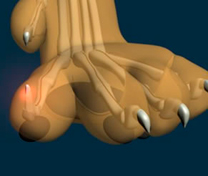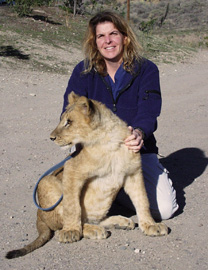DECLAW SURGERY –
HEALTH PROBLEMS DUE TO DECLAWING
Big cats are declawed by their owners with the intention of making the animals less dangerous to handle. Typically, the owners are private collectors who are trying to make a household “pet” out of a feral feline that is, by nature, not a suitable pet. It is rare for public zoos to have declawed cats. Unfortunately, the tiger or cougar that was cute and playful as a cub can be dangerous as an adult, whether or not it has claws. A “pet” that weighs several hundred pounds and eats twenty pounds of meat a day may no longer seem like such a good idea. These cats, victims of human ignorance or arrogance, are sometimes killed. The luckier ones find themselves abandoned or confiscated by authorities and become residents of an animal refuge. There are over a hundred such sanctuaries in the U.S. alone, housing thousands of declawed big cats.
Millions of domestic (house) cats have had declaw (partial digital amputation) surgery since it was first popularized in the United States and Canada in the 1950s. Declawing has never been common in most other countries, and, in fact, it is illegal or considered unethical by the veterinary profession in most of the world.
Declawing is a surgical procedure, sometimes inaccurately termed “onychectomy,” which means “removal of the nail.” In reality, more than just the nail is removed. The animal’s toes are amputated at the last joint, which is the only way to removed the nail (claw) that grows from deep within the toe bone. Most people do not realize that bone—not only the nail—is removed. Declaw surgery is usually performed when the animal is a cub or kitten. While some felines will have immediate complications from the procedure, it may be many months or years before the damaging effects of declawing become obvious. Declawing may result in permanent lameness, arthritis, and other long-term physical and behavioral complications.
Cats normally walk with their toes, bearing the weight of their bodies; each step is cushioned by the pad under the toe. Declawed cats experience extreme pain supporting their body weight when standing or walking, if the tendon attached to the retained segment of the third phalanx pulls that bit of bone under the foot. The displaced bone fragment produces a painful “pebble-in-the-shoe” sensation when they stand or try to walk. The video clip shown here illustrates why declaw surgery can cause debilitating injury in cats.

To compensate for the pain in their tender paws, cats will attempt to shift their weight farther back on their feet, in effect walking on their “wrists,” like Naala, an African lioness shown here (right). The stresses caused by the abnormal posture and movement, may produce arthritis in the legs, which, in turn, may cripple the cat further and cause it more suffering.

Also, bone fragments may contain remnants of nail-forming tissue that may continue to grow deep within the foot, causing infection. The pad is often displaced backwards, toward the rear of the foot, allowing the weight of the cat’s body to push the end of the second toe bone (second phalanx, or p2), through the thinned tissue on the underside of the foot. These complications may occur in combination, invariably resulting in great pain for the animal to stand or walk.

In more severe and particularly heartbreaking cases, the mutilation from declaw surgery may cause so much tenderness or pain that the animal can move only by walking on its “elbows,” like Kona, the mountain lion shown here (right).

In her former role as head veterinarian at a wildlife sanctuary, Dr. Jennifer Conrad founded The Paw Project, which initially rehabilitated big cats, such as lions, tigers, cougars, and jaguars, that have been maimed by declawing. She has been a proactive spokesperson advocating humane alternatives to declaw surgery and has been interviewed on numerous television and radio programs to educate the public about the mutilating effects of feline declawing. She has tirelessly supported legislative efforts in California to ban feline declawing, which is a practice banned in many industrialized countries throughout the world. In more recent years, reconstructive surgery has been performed successfully on domestic cat. Though the claws cannot be restored, many animals can be relieved of the pain and some of the consequences of declaw surgery.

